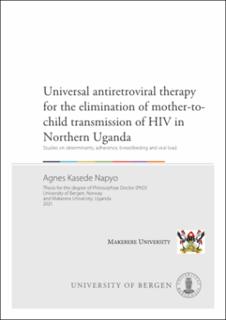Universal antiretroviral therapy for the elimination of mother-to-child transmission of HIV in Northern Uganda : Studies on determinants, adherence, breastfeeding and viral load
Doctoral thesis

Åpne
Permanent lenke
https://hdl.handle.net/11250/2759542Utgivelsesdato
2021-06-24Metadata
Vis full innførselSamlinger
Sammendrag
Background:
Uganda’s decrease in mother-to-child transmission of HIV (MTCT) has
stagnated, making it almost impossible to achieve the target of zero new HIV infections.
Objectives:
The aim of this study has been to determine, among a group of HIV infected women enrolled on universal antiretroviral treatment in Lira, Northern Uganda, the prevalence and factors associated with: a) unintended pregnancy, b) detectable viral load, c) infant nevirapine prophylaxis, and d) exclusive breastfeeding.
Methods:
A survey of 518 HIV-infected pregnant women in 2018 was to determine the prevalence and predictors for unintended pregnancy. Of the 518, 420 had their viral load monitored, from which we determined the risk factors for detectable viral load. These women were followed up on delivery and at 6 weeks when 472 mothers and their babies
were included in a prospective cohort analysis to measure barriers and enablers of adherence to infant nevirapine prophylaxis. The mother-infant pairs were followed up until 14 weeks, at which point the incidence and risk factors for non-exclusive breastfeeding were
longitudinally measured. Data were analysed using logistic regression models and generalised estimation equations for the Poisson family.
Results:
Of the 518 women enrolled in the study, 213 (41.1%) had unintended pregnancy (95% Confidence interval (CI): 36.8% - 45.5). Risk factors for unintended pregnancy were being single (adjusted odds ratio (AOR) = 3.74, 95% CI: 1.67 – 8.34), higher parity (parity of ≥5; AOR= 2.79, 95% CI: 1.85 – 4.22) and long-term ART (≥10 years; AOR=3.69, 95%
CI: 1.57 – 8.67). Detectable viral load (>50 copies/ml) was prevalent among 120 women [120/420; 30.7%: 95% CI: 26.3 - 35.4%)] and viral non-suppression (>1000 copies/ml) was at 8.1% (34/420; 95% CI: 5.7 – 11.1%). Factors associated with detectable viral load that
did not belong to the Lango ethnicity were: (other ethnicity: AOR = 1.92, 95% CI: 1.05 – 3.90), and taking a second-line regimen (protease inhibitor-based: AOR = 4.41, 95% CI: 1.13 – 17.22). A number of the infants did not keep to their nevirapine prophylaxis at 6 weeks of age (70/472; 14.8%, 95% CI: 11.7-18.4%). Barriers to infant adherence were
younger maternal age (≤20 years; adjusted risk ratio (ARR) =1.55; 95% CI: 1.1 – 2.2), did not take a viral load test during pregnancy (ARR: 1.4; 95% CI: 1.1 – 1.7), and mothers not receiving nevirapine syrup for the baby after childbirth (ARR = 6.2; 95% CI: 5.1 – 7.6).
Enablers were maternal characteristics including: having attained ≥14 years of schooling Mother-to-child transmission of HIV in Northern Uganda (ARR = 0.7; 95% CI: 0.5 – 0.9), taking a nevirapine-based regimen (ARR = 0.6; 95% CI: 0.4 – 0.9), being on long-term ART (≥ 60 months ARR = 0.75; 95% CI: 0.6 – 0.9), being accompanied by a husband to hospital during labour and childbirth (ARR = 0.5; 95% CI:
0.4 – 0.7) and labour pains starting at night (ARR = 0.7; 95% CI: 0.6 – 0.8). The rate of exclusive breastfeeding decreased with increasing age of the infants, and by 14 weeks of age almost half were not exclusively breastfeeding (200/466; 42.9%, 95% CI: 38.3-47.5%). Risk
factors for non-exclusive breastfeeding included the mother: belonging to the highest socioeconomic strata (ARR = 1.5, 95% CI: 1.01 – 2.1), delivering under the supervision of a non-health worker (ARR=1.6, 95% CI: 1.01 – 2.7), and the mother not adhering to her ART during pregnancy (ARR=1.3, 95% CI: 1.01 – 1.7).
Conclusion: HIV infected women at risk of infecting their infants include the younger age
group, unmarried, non-native to Lira, non-adherent to ART, have recently just began taking ART, had deliveries unsupervised by a health worker, and those that did not receive nevirapine syrup for their infant after childbirth. We recommend that attention should be focused on these critical groups during the implementation of PMTCT programs in Lira, Northern Uganda and in contexts similar to it.
Består av
Paper I: Agnes Napyo, Victoria Nankabirwa, David Mukunya, Josephine Tumuhamye, Grace Ndeezi, Anna Agnes Ojok Arach, Beatrice Odongkara, Paul Waako, Thorkild Tylleskär, James K. Tumwine: Prevalence and predictors for unintended pregnancy among HIVpositive pregnant women in Lira, Northern Uganda: a cross-sectional study. Sci Rep. 2020;10:16319. The article is available in the thesis. The article is also available at: https://doi.org/10.1038/s41598-020-73490-6Paper II: Agnes Napyo, James K Tumwine, David Mukunya, Josephine Tumuhamye, Anna Agnes Ojok Arach, Grace Ndeezi, Paul Waako, Thorkild Tylleskär: Detectable HIV-RNA viral load among HIV-infected pregnant women on treatment in Northern Uganda. Int J MCH AIDS. 2020;9(2):232-241. The article is available in the thesis. The article is also available at: https://doi.org/10.21106/ijma.374
Paper III: Agnes Napyo, Thorkild Tylleskär, David Mukunya, Josephine Tumuhamye, Musaba Milton, Anna Agnes Ojok Arach, Paul Waako, James K Tumwine, Grace Ndeezi: Barriers and enablers of adherence to infant nevirapine prophylaxis against HIV 1 transmission among 6-week-old HIV exposed infants: a prospective cohort study in Northern Uganda. PLoS ONE .2020; 15(10): e0240529. The article is available at: https://hdl.handle.net/11250/2759535
Paper IV: Agnes Napyo, James K Tumwine, David Mukunya, Paul Waako, Thorkild Tylleskär, Grace Ndeezi: Exclusive breastfeeding among HIV exposed infants 1 from birth to 14 weeks of life in Lira, Northern Uganda: A prospective cohort study. Global Health Action. 2020; 13(1): 1833510. The article is available at: https://hdl.handle.net/11250/2730167
